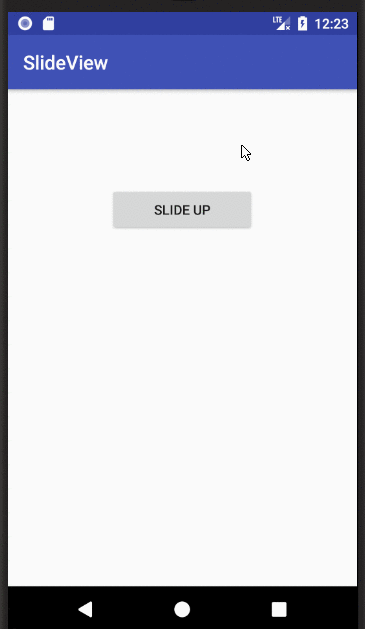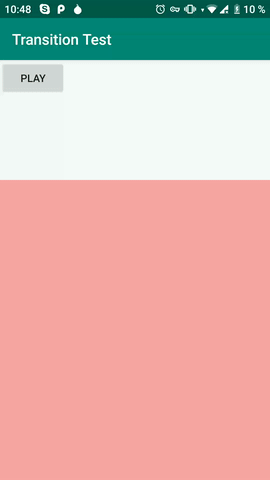使用上下滑动动画显示和隐藏视图
Answers:
借助Android 3.0(Honeycomb)中引入的新动画API,创建此类动画非常简单。
View向下滑动一段距离:
view.animate().translationY(distance);您以后可以View像这样将后盖滑回其原始位置:
view.animate().translationY(0);您还可以轻松地组合多个动画。以下动画将View向下滑动其高度,并同时使其淡入:
// Prepare the View for the animation
view.setVisibility(View.VISIBLE);
view.setAlpha(0.0f);
// Start the animation
view.animate()
.translationY(view.getHeight())
.alpha(1.0f)
.setListener(null);然后,您可以淡出View后背并将其滑回到其原始位置。我们还设置了一个,AnimatorListener以便我们可以在动画完成后将View背面的可见性设置GONE为:
view.animate()
.translationY(0)
.alpha(0.0f)
.setListener(new AnimatorListenerAdapter() {
@Override
public void onAnimationEnd(Animator animation) {
super.onAnimationEnd(animation);
view.setVisibility(View.GONE);
}
});View当其可见性设置为时,您要通过设置动画来实现View.GONE什么?如果将其可见性设置为除其他以外View.VISIBLE,View则将不可见。我不明白你在问什么。如果您希望动画可见,请不要将的可见性设置View为View.GONE。
onAnimationEnd被要求多发生的动画,这意味着,每一次onAnimationEnd也被称为时得到所示的视图,设置它的知名度已经一去不复返了,等等
我在理解应用接受的答案时遇到了麻烦。我需要更多背景信息。现在我已经弄清楚了,这里是一个完整的示例:

MainActivity.java
public class MainActivity extends AppCompatActivity {
Button myButton;
View myView;
boolean isUp;
@Override
protected void onCreate(Bundle savedInstanceState) {
super.onCreate(savedInstanceState);
setContentView(R.layout.activity_main);
myView = findViewById(R.id.my_view);
myButton = findViewById(R.id.my_button);
// initialize as invisible (could also do in xml)
myView.setVisibility(View.INVISIBLE);
myButton.setText("Slide up");
isUp = false;
}
// slide the view from below itself to the current position
public void slideUp(View view){
view.setVisibility(View.VISIBLE);
TranslateAnimation animate = new TranslateAnimation(
0, // fromXDelta
0, // toXDelta
view.getHeight(), // fromYDelta
0); // toYDelta
animate.setDuration(500);
animate.setFillAfter(true);
view.startAnimation(animate);
}
// slide the view from its current position to below itself
public void slideDown(View view){
TranslateAnimation animate = new TranslateAnimation(
0, // fromXDelta
0, // toXDelta
0, // fromYDelta
view.getHeight()); // toYDelta
animate.setDuration(500);
animate.setFillAfter(true);
view.startAnimation(animate);
}
public void onSlideViewButtonClick(View view) {
if (isUp) {
slideDown(myView);
myButton.setText("Slide up");
} else {
slideUp(myView);
myButton.setText("Slide down");
}
isUp = !isUp;
}
}activity_mail.xml
<?xml version="1.0" encoding="utf-8"?>
<RelativeLayout
xmlns:android="http://schemas.android.com/apk/res/android"
xmlns:tools="http://schemas.android.com/tools"
android:layout_width="match_parent"
android:layout_height="match_parent"
tools:context="com.example.slideview.MainActivity">
<Button
android:id="@+id/my_button"
android:layout_centerHorizontal="true"
android:layout_marginTop="100dp"
android:onClick="onSlideViewButtonClick"
android:layout_width="150dp"
android:layout_height="wrap_content"/>
<LinearLayout
android:id="@+id/my_view"
android:background="#a6e1aa"
android:orientation="vertical"
android:layout_alignParentBottom="true"
android:layout_width="match_parent"
android:layout_height="200dp">
</LinearLayout>
</RelativeLayout>笔记
.setVisibility(View.INVISIBLE);向上滑动功能,将无法按预期的效果工作。
Translate Animation移动视图。如果您想为视图本身缩放设置动画,请使用ScaleAnimation anim = new ScaleAnimation(1, 1, 0, 1)
现在,应该通过Transition API支持(androidx)包中的可用动画来完成可见性更改动画。只需使用Slide Transition调用TransitionManager.beginDelayedTransition方法,然后更改视图的可见性即可。
import androidx.transition.Slide;
import androidx.transition.Transition;
import androidx.transition.TransitionManager;
private void toggle(boolean show) {
View redLayout = findViewById(R.id.redLayout);
ViewGroup parent = findViewById(R.id.parent);
Transition transition = new Slide(Gravity.BOTTOM);
transition.setDuration(600);
transition.addTarget(R.id.redLayout);
TransitionManager.beginDelayedTransition(parent, transition);
redLayout.setVisibility(show ? View.VISIBLE : View.GONE);
}activity_main.xml
<?xml version="1.0" encoding="utf-8"?>
<RelativeLayout xmlns:android="http://schemas.android.com/apk/res/android"
android:id="@+id/parent"
android:layout_width="match_parent"
android:layout_height="match_parent"
android:orientation="vertical">
<Button
android:id="@+id/btn"
android:layout_width="wrap_content"
android:layout_height="wrap_content"
android:text="play" />
<LinearLayout
android:id="@+id/redLayout"
android:layout_width="match_parent"
android:layout_height="400dp"
android:background="#5f00"
android:layout_alignParentBottom="true" />
</RelativeLayout>请使用另一个默认和自定义转换示例来检查此答案。
minSdkVersion 21
androidx软件包。它在pre 21 API上运行良好。
最简单的解决方案:将其android:animateLayoutChanges="true"放在保存您的视图的容器上。
置于某种上下文中:如果您具有如下所示的布局,则此容器中视图的所有可见性更改都将自动设置为动画。
<LinearLayout android:id="@+id/container"
android:layout_width="match_parent"
android:layout_height="match_parent"
android:animateLayoutChanges="true"
>
<Views_which_change_visibility>
</LinearLayout>您可以在“ 动画布局更改”中找到有关此内容的更多详细信息-Android开发者
您可以通过创建的新子类并重写以启动,从而Animation在LinearLayout更改的可见性正确时启动正确的代码。考虑这样的事情:LinearLayoutsetVisibility()Animations
public class SimpleViewAnimator extends LinearLayout
{
private Animation inAnimation;
private Animation outAnimation;
public SimpleViewAnimator(Context context)
{
super(context);
}
public void setInAnimation(Animation inAnimation)
{
this.inAnimation = inAnimation;
}
public void setOutAnimation(Animation outAnimation)
{
this.outAnimation = outAnimation;
}
@Override
public void setVisibility(int visibility)
{
if (getVisibility() != visibility)
{
if (visibility == VISIBLE)
{
if (inAnimation != null) startAnimation(inAnimation);
}
else if ((visibility == INVISIBLE) || (visibility == GONE))
{
if (outAnimation != null) startAnimation(outAnimation);
}
}
super.setVisibility(visibility);
}
}View负责自己的动画,这是从来没有你想要的。想象一下,您想View在应用程序的另一部分中对动画进行不同的设置。那你怎么办呢?添加标记以不自动设置可见性动画?为View和覆盖子类setVisibility()以删除动画?或更糟糕的是setVisibility()用另一个动画来实现?从那里变得越来越丑陋。不要使用此“解决方案”。
科特林
根据Suragch的答案,这是使用View扩展的一种优雅方法:
fun View.slideUp(duration: Int = 500) {
visibility = View.VISIBLE
val animate = TranslateAnimation(0f, 0f, this.height.toFloat(), 0f)
animate.duration = duration.toLong()
animate.fillAfter = true
this.startAnimation(animate)
}
fun View.slideDown(duration: Int = 500) {
visibility = View.VISIBLE
val animate = TranslateAnimation(0f, 0f, 0f, this.height.toFloat())
animate.duration = duration.toLong()
animate.fillAfter = true
this.startAnimation(animate)
}然后,无论你想使用它,你只需要myView.slideUp()或myView.slideDown()
if (filter_section.getVisibility() == View.GONE) {
filter_section.animate()
.translationY(filter_section.getHeight()).alpha(1.0f)
.setListener(new AnimatorListenerAdapter() {
@Override
public void onAnimationStart(Animator animation) {
super.onAnimationStart(animation);
filter_section.setVisibility(View.VISIBLE);
filter_section.setAlpha(0.0f);
}
});
} else {
filter_section.animate()
.translationY(0).alpha(0.0f)
.setListener(new AnimatorListenerAdapter() {
@Override
public void onAnimationEnd(Animator animation) {
super.onAnimationEnd(animation);
filter_section.setVisibility(View.GONE);
}
});
}setAlpha干什么的?
您可以通过在Android应用中使用以下代码在任何视图或布局上上下滑动
boolean isClicked=false;
LinearLayout mLayoutTab = (LinearLayout)findViewById(R.id.linearlayout);
if(isClicked){
isClicked = false;
mLayoutTab.animate()
.translationYBy(120)
.translationY(0)
.setDuration(getResources().getInteger(android.R.integer.config_mediumAnimTime));
}else{
isClicked = true;
mLayoutTab.animate()
.translationYBy(0)
.translationY(120)
.setDuration(getResources().getInteger(android.R.integer.config_mediumAnimTime));
}使用此类:
public class ExpandCollapseExtention {
public static void expand(View view) {
view.setVisibility(View.VISIBLE);
final int widthSpec = View.MeasureSpec.makeMeasureSpec(0, View.MeasureSpec.UNSPECIFIED);
final int heightSpec = View.MeasureSpec.makeMeasureSpec(0, View.MeasureSpec.UNSPECIFIED);
view.measure(widthSpec, heightSpec);
ValueAnimator mAnimator = slideAnimator(view, 0, view.getMeasuredHeight());
mAnimator.start();
}
public static void collapse(final View view) {
int finalHeight = view.getHeight();
ValueAnimator mAnimator = slideAnimator(view, finalHeight, 0);
mAnimator.addListener(new Animator.AnimatorListener() {
@Override
public void onAnimationEnd(Animator animator) {
view.setVisibility(View.GONE);
}
@Override
public void onAnimationStart(Animator animation) {
}
@Override
public void onAnimationCancel(Animator animation) {
}
@Override
public void onAnimationRepeat(Animator animation) {
}
});
mAnimator.start();
}
private static ValueAnimator slideAnimator(final View v, int start, int end) {
ValueAnimator animator = ValueAnimator.ofInt(start, end);
animator.addUpdateListener(new ValueAnimator.AnimatorUpdateListener() {
@Override
public void onAnimationUpdate(ValueAnimator valueAnimator) {
int value = (Integer) valueAnimator.getAnimatedValue();
ViewGroup.LayoutParams layoutParams = v.getLayoutParams();
layoutParams.height = value;
v.setLayoutParams(layoutParams);
}
});
return animator;
}
}使用ObjectAnimator
private fun slideDown(view: View) {
val height = view.height
ObjectAnimator.ofFloat(view, "translationY", 0.toFloat(), height.toFloat()).apply {
duration = 1000
start()
}
}
private fun slideUp(view: View) {
val height = view.height
ObjectAnimator.ofFloat(view, "translationY", height.toFloat(),0.toFloat()).apply {
duration = 1000
start()
}
}0.toFloat()也可以是0f
我有一个极端的情况,我的视线高度仍然zero如此...
import android.animation.Animator;
import android.animation.AnimatorListenerAdapter;
import android.view.View;
public final class AnimationUtils {
public static void slideDown(final View view) {
view.animate()
.translationY(view.getHeight())
.alpha(0.f)
.setListener(new AnimatorListenerAdapter() {
@Override
public void onAnimationEnd(Animator animation) {
// superfluous restoration
view.setVisibility(View.GONE);
view.setAlpha(1.f);
view.setTranslationY(0.f);
}
});
}
public static void slideUp(final View view) {
view.setVisibility(View.VISIBLE);
view.setAlpha(0.f);
if (view.getHeight() > 0) {
slideUpNow(view);
} else {
// wait till height is measured
view.post(new Runnable() {
@Override
public void run() {
slideUpNow(view);
}
});
}
}
private static void slideUpNow(final View view) {
view.setTranslationY(view.getHeight());
view.animate()
.translationY(0)
.alpha(1.f)
.setListener(new AnimatorListenerAdapter() {
@Override
public void onAnimationEnd(Animator animation) {
view.setVisibility(View.VISIBLE);
view.setAlpha(1.f);
}
});
}
}这是我的解决方案。只需获取对您的视图的引用,然后调用此方法:
public static void animateViewFromBottomToTop(final View view){
view.getViewTreeObserver().addOnGlobalLayoutListener(new ViewTreeObserver.OnGlobalLayoutListener() {
@Override
public void onGlobalLayout() {
view.getViewTreeObserver().removeOnGlobalLayoutListener(this);
final int TRANSLATION_Y = view.getHeight();
view.setTranslationY(TRANSLATION_Y);
view.setVisibility(View.GONE);
view.animate()
.translationYBy(-TRANSLATION_Y)
.setDuration(500)
.setStartDelay(200)
.setListener(new AnimatorListenerAdapter() {
@Override
public void onAnimationStart(final Animator animation) {
view.setVisibility(View.VISIBLE);
}
})
.start();
}
});
}无需执行其他任何操作=)
苏拉奇在科特林的回答。这对我有用。
class MainActivity : AppCompatActivity() {
var isUp: Boolean = false
override fun onCreate(savedInstanceState: Bundle?) {
super.onCreate(savedInstanceState)
setContentView(R.layout.activity_main)
var myView: View = findViewById(R.id.my_view)
var myButton: Button = findViewById(R.id.my_button)
//Initialize as invisible
myView.visibility = View.INVISIBLE
myButton.setText("Slide up")
isUp = false
}
fun View.slideUp(duration: Int = 500){
visibility = View.VISIBLE
val animate = TranslateAnimation(0f, 0f, this.height.toFloat(), 0f)
animate.duration = duration.toLong()
animate.fillAfter = true
this.startAnimation(animate)
}
fun View.slideDown(duration: Int = 500) {
visibility = View.VISIBLE
val animate = TranslateAnimation(0f, 0f, 0f, this.height.toFloat())
animate.duration = duration.toLong()
animate.fillAfter = true
this.startAnimation(animate)
}
fun onSlideViewButtonClick(view: View){
if(isUp){
my_view.slideDown()
my_button.setText("Slide Up")
}
else{
my_view.slideUp()
my_button.setText("Slide Down")
}
isUp = !isUp
}}
您可以使用简单的三行代码来显示动画...
//getting the hiding view by animation
mbinding.butn.setOnClickListener {
val SlideOutLeft = AnimationUtils.loadAnimation(this, R.anim.slide_out_left)
simplelayout.visibility = View.INVISIBLE
simplelayout.startAnimation(SlideOutLeft)
val SlideInRight = AnimationUtils.loadAnimation(applicationContext, R.anim.slide_in_right)
animation1.visibility = View.VISIBLE
animation1.startAnimation(SlideInRight)
}
//again unhide the view animation
mbinding.buttn.setOnClickListener {
val SlideInLeft=AnimationUtils.loadAnimation(this,R.anim.slide_in_left)
//set the layout
simplelayout.visibility=View.VISIBLE
simplelayout.startAnimation(SlideInLeft)
val SlideOutRight=AnimationUtils.loadAnimation(this,R.anim.slide_out_right)
animation1.visibility=View.INVISIBLE
animation1.startAnimation(SlideOutRight)
}使用Kotlin扩展,您可以使用以下命令:
enum class SlideDirection{
UP,
DOWN,
LEFT,
RIGHT
}
enum class SlideType{
SHOW,
HIDE
}
fun View.slideAnimation(direction: SlideDirection, type: SlideType, duration: Long = 250){
val fromX: Float
val toX: Float
val fromY: Float
val toY: Float
val array = IntArray(2)
getLocationInWindow(array)
if((type == SlideType.HIDE && (direction == SlideDirection.RIGHT || direction == SlideDirection.DOWN)) ||
(type == SlideType.SHOW && (direction == SlideDirection.LEFT || direction == SlideDirection.UP)) ){
val displayMetrics = DisplayMetrics()
val windowManager = context.getSystemService(Context.WINDOW_SERVICE) as WindowManager
windowManager.defaultDisplay.getMetrics(displayMetrics)
val deviceWidth = displayMetrics.widthPixels
val deviceHeight = displayMetrics.heightPixels
array[0] = deviceWidth
array[1] = deviceHeight
}
when (direction) {
SlideDirection.UP -> {
fromX = 0f
toX = 0f
fromY = if(type == SlideType.HIDE) 0f else (array[1] + height).toFloat()
toY = if(type == SlideType.HIDE) -1f * (array[1] + height) else 0f
}
SlideDirection.DOWN -> {
fromX = 0f
toX = 0f
fromY = if(type == SlideType.HIDE) 0f else -1f * (array[1] + height)
toY = if(type == SlideType.HIDE) 1f * (array[1] + height) else 0f
}
SlideDirection.LEFT -> {
fromX = if(type == SlideType.HIDE) 0f else 1f * (array[0] + width)
toX = if(type == SlideType.HIDE) -1f * (array[0] + width) else 0f
fromY = 0f
toY = 0f
}
SlideDirection.RIGHT -> {
fromX = if(type == SlideType.HIDE) 0f else -1f * (array[0] + width)
toX = if(type == SlideType.HIDE) 1f * (array[0] + width) else 0f
fromY = 0f
toY = 0f
}
}
val animate = TranslateAnimation(
fromX,
toX,
fromY,
toY
)
animate.duration = duration
animate.setAnimationListener(object: Animation.AnimationListener{
override fun onAnimationRepeat(animation: Animation?) {
}
override fun onAnimationEnd(animation: Animation?) {
if(type == SlideType.HIDE){
visibility = View.INVISIBLE
}
}
override fun onAnimationStart(animation: Animation?) {
visibility = View.VISIBLE
}
})
startAnimation(animate)
}扩展示例:
view.slideAnimation(SlideDirection.UP, SlideType.HIDE)//to make it disappear through top of the screen
view.slideAnimation(SlideDirection.DOWN, SlideType.SHOW)//to make it reappear from top of the screen
view.slideAnimation(SlideDirection.DOWN, SlideType.HIDE)//to make it disappear through bottom of the screen
view.slideAnimation(SlideDirection.UP, SlideType.SHOW)//to make it reappear from bottom of the screen